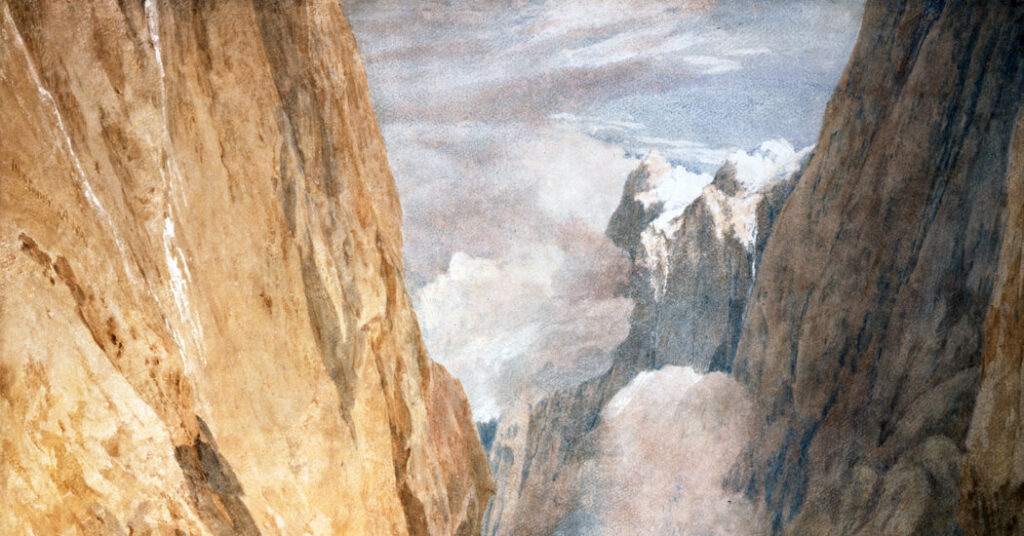There’s a choose-your-fighter aspect to the blockbuster exhibition of England’s two most famous landscape painters that opens Friday at Tate Britain in London.
“Turner and Constable: Rivals and Originals” pairs the impressive oeuvres of two artists who were born just a year apart — J.M.W. Turner in 1775 and John Constable in 1776 — and were endlessly compared both during their lifetimes and long after. They were like “fire and water,” one 19th-century critic wrote, as if their canvases were polar opposites.
The show, which runs until April 12, celebrates the 250th anniversaries of the artists’ births and opens with a kind of timeline of their milestones, personal and professional: birth, education, first show, first press mention, total exhibitions, number of works and — as every life concludes — death. Turner made it to 76; Constable, only 60.
Although Turner came from humbler beginnings — his father was a barber and his mother was in and out of mental asylums — he began his painting studies at 14, giving him a head start on the more affluent Constable. The Constable family were corn merchants, and they were nervous about their son pursuing an artistic vocation. Although he worked diligently on his own, he only began formal training at 23.
They both trained at the Royal Academy of Arts in London, which was a pivotal place for both throughout their lives — first its schools, then its public exhibitions, and ultimately official membership as Academicians.
You could go through the exhibition, which proceeds chronologically, contrasting the two men as they make their first self-portraits, paint the countryside close to home, venture farther afield and circle each other at the Royal Academy’s prestigious annual exhibition, at which reputations could be made or broken.
But as its title — “Rivals and Originals” — emphasizes, Turner and Constable, though perhaps fueled by competition, both avowedly plowed their own furrows and developed distinct approaches to landscape painting. This was by no means the most popular genre when both artists started working, and their dedication to finding new ways of representing the natural world placed them at the margins of tradition — and then at the forefront of a new English Romanticism.
A small 1790 self-portrait by Turner at age 15 shows his early facility with delicate drawing and watercolor. In works on paper that follow, we immediately see how his interest in weather transformed images of otherwise conventional late-18th-century subject matter.
A dark storm cloud hangs over a ruined abbey with a band of travelers passing by in the foreground; a view of Salisbury Cathedral shows the Gothic building glowing and immaculately detailed in the raking sunlight; boats are thrown about on tumultuous waters as they approach a rocky coast.
That last one is “The Rising Squall, Hot Wells, from St. Vincent’s Rock, Bristol,” the first work Turner ever exhibited, aged 17, and it has not been on public display since 1858. A watercolor, it is all undulation: boulders, churning water, dusky hills and misty trees in the background, all painted in extraordinary shades of blue that crop up again in later works, like the ethereal “The Blue Rigi, Sunrise” (1842) and “The Lagoon in Venice, at Sunset” (1840).
Turner’s large later canvases are awash in blues and swirling with maelstrom skies of snow and rain, but they are also frequently filled with blazing suns and burning flames — as in explosive “The Burning of the Houses of Lords and Commons, 16 October 1834” (1835), or the nearly abstract “Norham Castle, Sunrise” (1842) — as if his pursuit were to capture not just the elements but their atmospheric sense.
Constable, too, turned his eye to the weather to study the landscape around him. The artist stayed more local than Turner, painting the hills, vales and rivers of Suffolk, a county in the east of England, so many times that his part of the world is now often referred to as “Constable Country.” Although he was often seen as a more bucolic painter who depicted farming scenes and working life on the River Stour, his canvases are nonetheless filled with movement and energy.
Clouds are highflying, muscular, billowing with light and shade, limned with gold, blue, pink, gray, mauve and brightest white. In most canvases, the sky, which Constable said “governs everything,” makes up two-thirds of the composition. Trees, tall and wind whipped, often frame the sky, their greenery almost impossibly alive.
One wall in the exhibition gathers six of Constable’s “cloud studies,” made of the skies over what is now North London from 1820 to 1822, whose variety show how carefully he studied nature — a process he called, with appropriate poetry, “skying.”
Another delight in the show, which pays close attention to the work behind the finished paintings, is a display of several of Turner’s more than 300 sketchbooks. In some of these, the weather has left a literal mark on the images: The pages are splashed with rain, a testament to Turner’s dogged outdoor sketching.
Other notebooks show experiments with color chemistry, or the extensive preparations the artist made before traveling across Europe to paint new landscapes, including elaborately plotting walking routes and noting useful foreign phrases.
There are many vast, stunning, richly colored canvases in “Turner and Constable: Rivals and Originals,” whether you prefer Turner’s glowing, diffuse light or Constable’s churning, emotional skies — or like both. What is most evident, most moving, is how much time each took to look at the world around them: the wind, the sky, the clouds, the water, the greenery, the light at different times of day. To marvel at it, and then to preserve it in images that remind us to do the same.
Turner and Constable: Rivals and Originals Through April 12 at Tate Britain in London; tate.org.uk.
The post These Rivals Wanted Art Fans to Pick a Side. This Show Lets You Choose Both. appeared first on New York Times.




